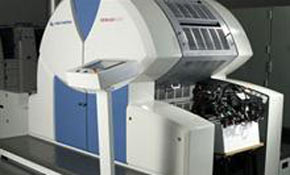
When was the machine launched and what market is aimed at?
The KBA Genius first appeared at Drupa 2004 and the German manufacturer added a UV fitment to the waterless B3 short-run press a year later. The machine was first pitched at the packaging and coldset sectors as an alternative to screen print on plastic film, but the addition of UV technology meant it could also be used to print loyalty and business cards, as well as standard board work. It can print on a wide range of materials. In April of this year, KBA unveiled a changeable-blade chamber system for the press that, it says, can reduce set-up times by up to one-third.
How does it work?
Being waterless and rollerless, many of the tasks associated with conventional offset printing have been eliminated. For example, there’s no need to adjust the ink zones, damping units and roller inking units, and you don’t have to control the ink-water equilibrium. When waterless technology first appeared, it received mixed reviews. Jack Malki, from local distributor Jet Technologies, says it is of great benefit that the press is “up to colour” by the 10th sheet, especially given the cost of substrates. “Plastics are expensive. Lenticular sheets can be $2-$3 each so you don’t want to waste them. But don’t just think about plastics: look at how much paper has gone up in price. If you can print 25 jobs per shift and you are only wasting, say, 15 sheets on each of them – do the math.” Quality is maintained by the fact that the anilox roller, blanket plate cylinder and printing cylinder all have exactly the same diameter, which eliminates the possibility of ghosting.
What’s its USP?
The Genius is one of currently only a handful of waterless presses available on the market. It stands out as its units sit in a V-shape formation around a fourfold central impression cylinder, which means the substrate doesn’t have to travel through a set of transfer grippers, ensuring an accurate register.
What’s the competition?
Malki says that while the closest rival would be the Presstek 52 DI, he sees the main competition from digital presses such as HP Indigo or conventional presses, such as a Ryobi or Heidelberg Speedmaster (the Anicolor would be another rival). “Those that say they want a digital press, we show them that even for short runs of 100-200 sheets, the Genius compares favourably. Unless you are doing variable data, it lets printers compete very favourably with digital for very short runs and with conventional offset up to 10,000 sheets,” says Malki.
What benefits does the new changeable-blade system give?
KBA says they have seen, on average, makeready times reduced by 30%-40% when the changeable blade system is used. This saving is down to the fact that ink no longer has to be removed from the blade chamber with a spatula while the machine is sitting idle. Once used, the blade chamber is instead simply levered out of the press and replaced with a clean one. The used chamber goes into a washing box offline, which cleans the ink off ready for its next use. In its closed state, the new chamber system can hold more ink than before, and ink can be refilled on the fly, saving more time. It’s also worth noting that the changeable blade system is retrofittable to existing Genius models.
What level of service and support can printers expect?
Malki describes the Genius as a “very trainable product”, and says how long it takes to get up to speed really depends on the operator’s background. “The offset people like it because they understand feeders and deliveries and ink. We would typically say an existing printer would need three to four days training maximum. We find that digital guys – as a real generalisation – are better with pre-press, but they need to be taught a little bit more about feeder adjustments. That is probably the hardest bit for someone who hasn’t printed before.” He says the maximum would be two weeks. Should anything go wrong with the press, Jet Technologies has a local service organisation to deal with issues.
How flexible is the Genius and what’s the quality like?
Running at up to 8,000 sheets per hour with a 360x520mm max sheet size, the Genius handles a variety of plastics including PVC, PC, PS, ABS and PET.
How much does it cost and is there a sales target?
Prices can vary considerably depending on specs, but a fairly standard configuration will set you back $660,000, delivered, installed and with training. In what is a niche market, Jet has sold four models in Australia and New Zealand, including two with the new changeable blade system. “The clients love them,” says Malki.
Specifications
Max sheet size: 360x520mm
Min sheet size: 210x297mm
Max speed: 8,000sph
Substrates: Plastics, carton and paper from 0.1-0.8mm
Units: Four (five optional)
Plate change: Semi-automatic
Price: From $660,000
Contact: Jet Technologies (02) 8399 4999 www.genius52uv.com.au
Comment below to have your say on this story.
If you have a news story or tip-off, get in touch at editorial@sprinter.com.au.
Sign up to the Sprinter newsletter
